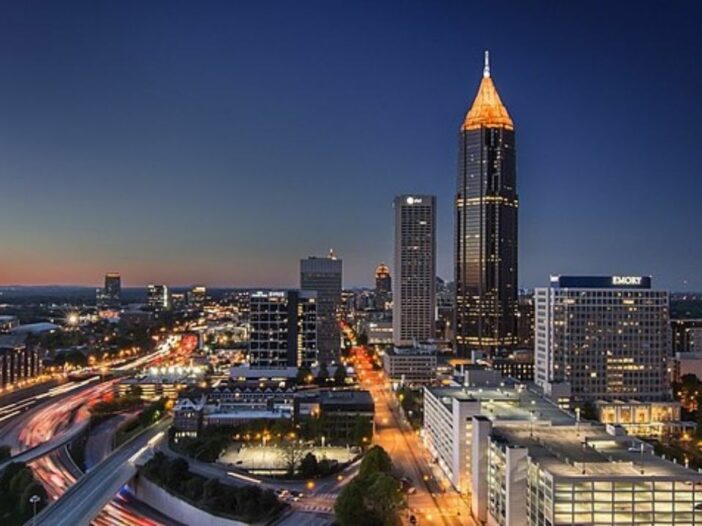
Now we all know how everyone left the city (on roads, in their cars) but to where did they go? That’s what episode three of The Making of Modern Atlanta is all about.
“The development of suburbs and exurbs raise many thorny issues for the making of modern Atlanta.”
The History Twins meet us by Arabia Mountain in DeKalb County. I love when they both go casual at the same time.
They are hanging out in the driveway of their producer’s log cabin in the forest. “He seems to think that this log cabin helps him maintain his ties with his Appalachian roots,” jokes Dr. White. “In the 1990s, even log cabins come with adjustable-rate mortgages,” adds Dr. Crimmins later.
White then tries to explain where all the interstates are. He calls I-285 “the archetypal Main Street of today’s urban America.” Ladies and gentlemen, behold the Tom Moreland Interchange, crudely nicknamed “spaghetti junction” after an ethnic dish. You’ll meet the man behind the traffic jam soon enough in this episode.
After that stressful trip on the interstate, let’s just be casual at a linear park. What’s this? No big deal! Just a guy with his hand on his hip, talking about Druid Hills and other planned suburbs!
They quote Warren Manning, landscape architect and Frederick Law Olmsted mentee: “Atlanta now begins to seriously feel the pangs of overcrowding, and to realize that something needs to be done. The solution requires the appreciation of and the need of adequate access to the landscape beauty of the region that the automobile now makes readily accessible to the city for homes and for vacation periods. Atlanta, tomorrow a city of a million, will by the year 2000 extend more than 15 miles out – far enough out on the spokes of transportation ways to permit radial roads to again pass off from secondary centers into the country. They will lead to industries and homes on the city’s south side, and to magnificent estates on the north – a piedmont picturesque.” (1922)
Innovative! And transportation planning in the 21st century still uses the same little calculations Manning ran to arrive at his radius distance. But seriously, this spokes concept is a great idea for the Atlanta regional roundtable to consider funding. Fifteen miles of radial roads out of Five Points so we can all get to our log cabins and vacation homes in Lithonia and Pine Lake.
The first ring of suburbs began, but guess who wasn’t invited to invest in and live amongst those tasteful lawns and well-apportioned Georgian and neoclassical manors? African Americans. The color line issue again. And so the birth of the black suburbs, starting along Ashby Street.
Sociologist Dr. Larry Earvin returns to discuss the westward and southern expansion of Atlanta’s black community. He briefly alludes to Mayor Allen’s Peyton Road barriers but TMOMA spends no more time highlighting this incident, which I think is a pretty major oversight when talking about “color lines” and how the city adjusted to the growing affluence and mobility of its African-American residents. So read more about it yourself here, here, and here.
The Wits’ End Players perform “Don’t Monkey with Peachtree.” The audience LOVES it.
Two things:
- At the time of his appearance in the parking lot of Briarcliff Plaza, the Plaza Thatre was playing La Femme Nikita for $2.50, according to the marquee.
- He pronounces Ponce de Leon weirdly. Something off about the “Leon” – like LEEÜNE in one quick syllable.
Lenox Square, Phipps Plaza, the Federal Aid Highway Act, more Leon (pronounced LEEÜNE) Eplan talking, George Goodwin talking. The three interstates are joined Dowtown. Leon Eplan talking more about interstates pulling people out of the center city into the suburbs, especially in the northside – “where lies our ultimate suburb, Dunwoody.”
